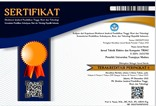Design and Evaluation of an IoT-Enabled ESP32 Photoplethysmography Monitor for Heart Rate and SpO₂
Abstract
Keywords
Full Text:
PDFReferences
B. Chong et al., “Global burden of cardiovascular diseases: projections from 2025 to 2050,” European Journal of Preventive Cardiology, vol. 32, no. 11, pp. 1001–1015, Aug. 2025, doi: 10.1093/eurjpc/zwae281.
D. R. Reddy, N. Saketh, and D. V. Sai, “Design and Development of Pulse Oximeter Using Internet of Things,” in 2022 6th International Conference on Intelligent Computing and Control Systems (ICICCS), IEEE, May 2022, pp. 455–458. doi: 10.1109/ICICCS53718.2022.9787989.
M. I. Kadhim, R. A. Fayadh, and J. F. Mahdi, “Design a medical device to monitor the human body (blood oxygen saturation, heart rate, body temperature),” in 2022 International Conference for Natural and Applied Sciences (ICNAS), IEEE, May 2022, pp. 52–57. doi: 10.1109/ICNAS55512.2022.9944718.
S. M. G. Mostafa, M. Zaki, M. M. Islam, M. S. Alam, and Md. A. Ullah, “Design and Implementation of an IoT-Based Healthcare Monitoring System,” in 2022 International Conference on Innovations in Science, Engineering and Technology (ICISET), IEEE, Feb. 2022, pp. 362–366. doi: 10.1109/ICISET54810.2022.9775850.
A. S. Hatem and J. K. Abed, “Design of Patient Health Monitoring Using ESP8266 and Adafruit IO Dashboard,” in 2022 International Conference on Electrical, Computer and Energy Technologies (ICECET), IEEE, Jul. 2022, pp. 1–6. doi: 10.1109/ICECET55527.2022.9872787.
M. J, S. S, S. A, Y. K, and S. K, “Detecting the Oxygen Saturation level and Heart Rate using MAX30100 Sensor,” in 2023 2nd International Conference on Vision Towards Emerging Trends in Communication and Networking Technologies (ViTECoN), IEEE, May 2023, pp. 1–5. doi: 10.1109/ViTECoN58111.2023.10157171.
N. bin Ahmed, S. Khan, N. A. Haque, and Md. S. Hossain, “Pulse Rate and Blood Oxygen Monitor to Help Detect Covid-19: Implementation and Performance,” in 2021 IEEE International IOT, Electronics and Mechatronics Conference (IEMTRONICS), IEEE, Apr. 2021, pp. 1–5. doi: 10.1109/IEMTRONICS52119.2021.9422520.
T. Esmaeiliazad, “Special Study of Earlobe Pulse Oximeter Using MAX30100 for Detecting SpO2 and Heart Beat,” ACADEMIC JOURNAL, 2021.
M. Nnamdi, P. Joboson, C. Bala, and C. D. Bala, “Monitoring Health Using IoT and Thingspeak,” Jul. 2024.
Ms. S. Pavithra, R. M. Guru, C. M. Shrimathi, S. Mounya, and R. M. Priya, “IoT Based Tracking System for Patients,” INTERANTIONAL JOURNAL OF SCIENTIFIC RESEARCH IN ENGINEERING AND MANAGEMENT, vol. 07, no. 03, Mar. 2023, doi: 10.55041/IJSREM18083.
V. V. S. Raghava, “A Study On Iot – Based Health Care System For Home Quarantine People,” International Journal of Environmental Sciences, vol. 11, no. 10s, pp. 7–14, Jun. 2025, doi: 10.64252/xy5ff012.
DOI: https://doi.org/10.21107/triac.v12i2.31989
Refbacks
- There are currently no refbacks.
Copyright (c) 2025 Jurnal Teknik Elektro dan Komputer TRIAC

This work is licensed under a Creative Commons Attribution-ShareAlike 4.0 International License.

 .
.











